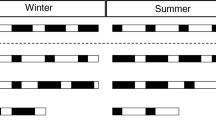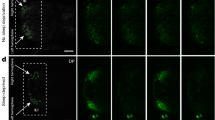Abstract
Arising from: O. Lyamin, J. Pryaslova, V. Lance & J. Siegel Nature 435, 1177 (2005); see also communication from Gnone et al.; Lyamin et al. reply.
Sleep has been assumed to be necessary for development and to be a vital function in mammals1,2 and other animals3,4. However, Lyamin et al.5 claim that in bottlenose dolphins (Tursiops truncatus) and killer whales (Orcinus orca), neonates and their mothers show almost no sleep behaviour for the first month after birth; this conclusion is based on their observation that the cetaceans keep swimming, avoid obstacles and rarely close their eyes for 24 hours a day throughout that period. Here we analyse the behaviour and eye closure of three neonate–mother pairs of bottlenose dolphins and find that, although the animals tend to open both eyes when surfacing to breathe, one or both eyes are closed during ‘swim rest’, an underwater sleeping behaviour that is associated with continuous activity. This observation calls into question the conclusions of Lyamin et al.5, who overlooked this type of sleep by analysing the animals’ eye state only when they surfaced to breathe.

Similar content being viewed by others
References
Hoppenbrouwers, T. & Sterman, M. B. Exp. Neurol. 49, 822–838 (1975).
Roffwarg, H. P., Muzio, J. N. & Dement, W. C. Science 152, 604–619 (1966).
Shaw, P. J., Tononi, G., Greenspan, R. J. & Robinson, D. F. Nature 417, 287–291 (2002).
Rechtschaffen, A., Gilliland, M. A., Bergmann, B. M. & Winter, J. B. Science 221, 182–184 (1983).
Lyamin, O., Pryaslova, J., Lance, V. & Siegel, J. Nature 435, 1177 (2005).
Mukhametov, L. M. Exp. Brain Res. 8, 227–238 (1984).
Lyamin, O. I., Mukhametov, L. M. & Siegel, J. M. Arch. Ital. Biol. 142, 557–568 (2004).
Lyamin, O. I. et al. Behav. Brain Res. 129, 125–129 (2002).
Sekiguchi, Y. & Kohshima, S. Physiol. Behav. 79, 643–653 (2003).
Goley, P. D. Mar. Mamm. Sci. 15, 1054–1064 (1999).
Author information
Authors and Affiliations
Corresponding author
Rights and permissions
About this article
Cite this article
Sekiguchi, Y., Arai, K. & Kohshima, S. Sleep in continuously active dolphins. Nature 441, E9–E10 (2006). https://doi.org/10.1038/nature04898
Published:
Issue Date:
DOI: https://doi.org/10.1038/nature04898
- Springer Nature Limited
This article is cited by
-
Local sleep and wakefulness—the concept and its potential for the understanding and treatment of insomnia disorder
Somnologie (2020)
-
Night-life of Bryde’s whales: ecological implications of resting in a baleen whale
Behavioral Ecology and Sociobiology (2018)
-
Sleep in continuously active dolphins; Activity and sleep in dolphins (Reply)
Nature (2006)





